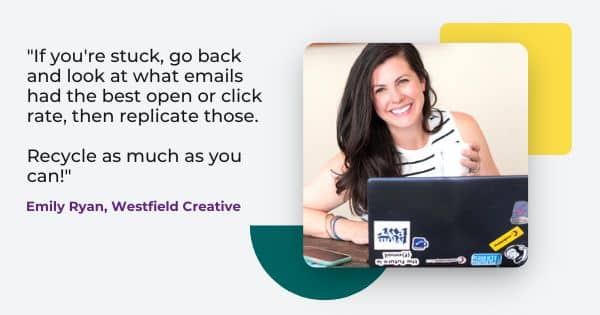
How to Get Fresh Newsletter Content Ideas – with 7 Expert Tips
We asked seven email experts how they come up with fresh newsletter content ideas. Check out their tips below, and you’ll never run out of topics.
Ask anyone who has an email newsletter and they pretty much all agree: sometimes, coming up with fresh topics is a challenge. Once you’ve covered the basics, how do you expand into other types of content – while keeping your audience engaged?
Your overall engagement plays a huge role in your email deliverability. The more people click, the higher your chances to be in the inbox.
Coming out with your emails on a timely basis is also crucial to building engagement and maintaining a good inbox rate.
But how do you find topics that keep people clicking – on repeat?
The tried-and-true ways experts get newsletter content ideas
We invited some real email brains out there to shed a little light on what we can do to get the ideas flowing. We asked the experts:
- what they keep in mind when creating a new email
- how they figure out what type of content most resonates with their audience
- and what tricks they use when their newsletters are due and they don’t know what to send.
Let’s see what they had to say.
Simon Harper, SRH Design: “Learn what content your audience likes.”
You want the idea for an email newsletter to resonate with your audience. Mailchimp expert Simon Harper of SRH Design wrote about this very challenge in his newsletter Mailchimp Mondays. (Do you subscribe?) Simon remarked:
“As you start to write more regularly, it does get easier. You engage more with your audience, and you start to learn what content your audience likes.”
That’s a great point. Don’t think so much about what you’d like to write about, but what your audience would like. What if you’re stuck, though?

Simon suggests:
- Gathering user-generated content to create an email campaign.
- Try reviving old blog posts that contain evergreen content.
- Write a thought piece on an industry-related topic.
- Has there been a change in your company, new staff hired? Introduce them, educate your audience.
- If you are an eCommerce brand, you might want to share some testimonials from customers or even what your favorite products are.
- You can even send out a survey to your audience to gather valuable data. Mailchimp has this feature built-in!
- If you are struggling, make sure you are signed up to your competitor’s email lists (they are subscribed to yours) and see what they have been writing about.
There is always something to write about, even if you think you’re stuck.”
— Simon Harper, Business Owner at SRH Design
Corina Leslie, ZeroBounce: “If you don’t have an idea you believe in, dig a little deeper.”
Our own email matriarch at ZeroBounce, Corina Leslie, strongly believes in the importance of email marketing metrics. You can use those metrics to help you fine-tune your content and come up with topics that feel fresh.
“Good ideas come from knowing your audience well and from keeping a close eye on your email marketing metrics,” she says.
Let’s hear a little more from her:
“I’ve been writing our newsletter for more than four years, and I study every detail in our reports. Open and click-through rates, unsubscribes (and their reasons), spam complaints, opening times. Then I compare those metrics to the data from our previous campaigns and draw useful feedback.
Sure, Apple’s MPP has affected the way we look at open rates. But our overall click rates don’t lie: they tell us exactly what people like and what they don’t care about so much.
What I’ve learned about the people on our list?
They want to know more about landing in the inbox. That’s why they come to ZeroBounce. So yes, we stick to this core topic. But since email deliverability is such a large puzzle, I can get creative.
I’m grateful for everyone who’s on our list – emailing these people is a privilege. So I scrutinize every topic and always wonder: how will this help them?
More than once I’ve felt that none of the topics I had were newsletter-worthy. When that happens, I reach out to one of our experts and do a quick Q&A to get some fresh email tips from them, like in this example here, with Brian Minick.
If you don’t have an idea you believe in, dig a little deeper. But also, it’s ok to not send anything until you do!”
— Corina Leslie, PR Manager at ZeroBounce
Vicky Smith, Flic Email: “I’ve signed up to Google Alerts on topics I write about”
Vicky Smith of Flic Email makes great use of Google Alerts to easily stay apprised of whatever is trending and fresh. Sometimes the answer to the question of what to write about in your email is right under your nose.
Here’s how Vicky gets email content ideas.
“When writing my own emails, I get a lot of inspiration from the projects I am working on and the conversations I have with clients and peers. I’ve learned to stop and think ‘if this is helping one person, perhaps it will help my whole audience.’

Also, I’ve signed up to Google Alerts on the topics I write about, which is a fantastic source of content if I am ever struggling with ideas.
I know if an idea is right for my audience when they take the time to hit reply and say ‘this really resonated.’ When this happens, I will often go on to share more on this, or similar, topics.
My core topics are email strategy and copywriting. It is what I do, what I talk about on my social media and on my website, and therefore it is what people expect from me!
I will often add in a fun P.S to my emails, but otherwise, I deliver what the subscriber signed up for.”
— Vicky Smith, Email Consultant, Strategist & Copywriter at Flic Email
Emily Ryan, Westfield Creative: “Ask your subscribers what they want to hear more about.”
Your audience dictates what your newsletter content should be. So, why not ask them what they want to read? Emily Ryan of Westfield Creative is full of ideas on… well, ideas.
Let’s check in with her:
“Sometimes the best emails come from the simplest ideas or thoughts. Every email does not need to be a deep story or a complex idea. Think of a funny thing that happened to you recently, or a time when you made a mistake. Or tell a story about your favorite client or customer.
Some of my best ideas come when I’m in the middle of doing something mundane (say laundry or dishes…) and think – ah-ha! That would be a great story to tell my audience.
Re-use content that worked well
Interestingly, one of the best ways to come up with quick content is to re-use old content that worked well.
If you’re stuck and have no idea, go back and look at what emails had the best open or click rate and then replicate those. People don’t realize that it was an email you sent a year ago – I promise. Recycle as much as you can!
It’s ok if some topics don’t land well
Sometimes you just have to test the waters and see what works and doesn’t work. It’s ok if some topics don’t land well. The best way to tell is if they engage with the content.
Did they click to ‘read more’ or did they reply and let you know they loved your email? Are there more unsubscribers than usual? The data will tell you so much about what works for your audience.
Also, it’s important to occasionally ask your subscribers what they want to hear more about. You could create a simple survey and ask them to check the options they’re interested in. This is incredibly helpful in shaping the types of content.

Have you picked your five core topics?
When coming up with ideas for your email it’s good to think of your key topics. I always recommend picking five topics for your brand that you cycle through. This works really well for social media posts too.
For example, for my own brand, I try to stick to these five things: email marketing tips, Mailchimp news, mom/parenting links, design tips, and inspiration, and ‘just for fun’ stuff (like a link to a great playlist). This helps show that I am well-rounded and hopefully keeps people interested.
So a great exercise is to think of the five topics for your own business.”
— Emily Ryan, Email Strategist & Co-Founder, Westfield Creative
Josh Brown, Helpjuice: “Survey whether the content they’re reading is relevant to them.”
Helpjuice’s Josh Brown points out that you should keep your eyes on one of the prizes: maximizing your engagement rates. So, how could you find out whether or not the content of your newsletters is resonating?
He has some pointers here:
“Before trying to generate newsletter content ideas or determining whether an idea is right, keep in mind that you want to maximize your engagement rates. Segment your list logically so you aren’t sending the same newsletter to everyone. Different people have different interests.
For example, our software caters to various verticals, so we create content on our blog for each of these audience types. So, when I look at segmentation for our newsletter, I look at what content a user was consuming before subscribing and start my segmentation off of that.
Someone who subscribed to our newsletter after reading a post on customer service best practices won’t have the same interests as someone who subscribed after reading a post on how to create an employee training and development program.
By separating these groups, it’s easier to come up with content ideas that would be of relevance to each group. Additionally, you can map to funnel to determine if you should have a more salesy type of content versus informational.
In terms of generating content that engages these segments, I do research to get a pulse on what’s of interest. That might mean reading industry blogs. It’s also a good idea to do a search on social media through hashtags and see what content gets good engagement. There’s also Google Trends, talking to our sales team, etc.
I also like to do a survey every so often where I run a 5-point Likert scale on whether the content they’re reading is relevant to them. Then, I have an open-ended question that asks the subscriber what type of content they’d like to see in future newsletters.
From there it’s all about looking at engagement rates to determine if you’re on the right track with the content for your particular segment.”
— Josh Brown, Marketing Manager, Helpjuice
Michelle Michaels, Versium: “Repurposing content is king.”
It’s tempting to believe that you always must run yourself ragged if you want to succeed. There are no shortcuts, right? Not so. Some of your best work is already done or at the very least, it’s well underway. Michelle Michaels at Versium knows the inherent value of repurposing your content. Read on.
“We source newsletter ideas from top content that we’ve launched in the past month or so.
I would change the adage ‘content is king’ to ‘repurposing content is king.’ It never hurts to reshare something that has earned high engagement in other marketing channels.
We also look at trending topics that would be relevant for our company to speak on. We can cover:
- events/webinars coming up (or recordings of recently released presentations)
- new product features or updates
- general company news that excites us internally. A company update that humanizes the business is just as important as a technical blog that educates our audience.
When you’re stuck, there are solutions. Ingest other content! Looking to companies I respect or who align with our values is the number one way I source inspiration when blocked. This could be podcasts, blogs, Instagram feeds, or even digging through my inbox for an email I remember really loving the theme or content of.
I’m lucky in the way that I’m a marketer who is marketing to marketers. I start with my intuition about how I would perceive a marketing message. But when it comes to honing in on niche segments of our contact list, it’s all about testing.
We test new ideas and learn in small batches. That way, if a particular piece of content has low engagement, we haven’t blasted our entire contact list with it.
But, do we have set subjects?
Yes and no.
We create content and speak to what is relevant to our business – data technology and how it relates to the martech world. But there are endless ways to layer those topics into what’s trending in the industry, so readers will be drawn to it. Or in innovative ways that position us as a thought leader in this space.”
— Michelle Michaels, Associate Marketing Director, Versium
Nicole Stevens, Mailbird: “We’re huge fans of psychographic marketing”
The folks over at Mailbird are all about psychographic marketing. What’s that? Psychographic marketing uses data about the personality, values, interests, and opinions of the individuals on your list. This information tells you not only who they are, but also why they engage or buy. Psychographic marketing can also be used with your email newsletters.
Nicole Stevens explains more.
“We’re huge fans of psychographic marketing, whereby we aim to understand our ideal customers’ aspirations, aims, fears and interests – and create content based on this. We are using social listening to understand these audiences more and capture tone and interests.
Audience attention span and retention are at the lowest they’ve ever been. Therefore, we repurpose content where we can.
So, a blog piece that was written even one year ago can be revamped into something relevant and evergreen.
The core topics usually include productivity and email hacks. However, being laser-focused on understanding our audience and their motivations, we can be confident in the value we share.”
— Nicole Stevens, Senior Marketing Manager, Mailbird
If you’re stumped, keep writing without fear
So, which ones of the tips above got you excited about your next email? Our guests gave us some smart tactics, so hopefully, getting newsletter content ideas should be easier now.
As for the writing process, there’s always the possibility that you’re psyching yourself out. Sometimes, you’re judging your ideas and plain getting frustrated with yourself. But remember that nobody has to know what you wrote in the early stages of a brainstorming session.
The heart of what you do is writing, and that includes newsletters or marketing emails. Author Natalie Goldberg’s book Writing Down the Bones is all about writing as a practice. Consider getting the book.
We all know that a blank page can be intimidating. As difficult as this may seem, it’s time to put pen to paper or keep your fingers tapping away at the keyboard.
If you don’t know where to start, “I’m thinking of…” is a great way to begin. Just write “I’m thinking of…” and the first thing that pops into your brain. Even if that first thought is silly or not related to your email newsletter topics. Who knows? Maybe it will prompt an idea.
Start writing and don’t stop. You’re almost there.
Table of Contents
- The tried-and-true ways experts get newsletter content ideas
- Simon Harper, SRH Design: “Learn what content your audience likes.”
- Corina Leslie, ZeroBounce: “If you don't have an idea you believe in, dig a little deeper.”
- Vicky Smith, Flic Email: “I’ve signed up to Google Alerts on topics I write about”
- Emily Ryan, Westfield Creative: “Ask your subscribers what they want to hear more about.”
- Re-use content that worked well
- It's ok if some topics don't land well
- Have you picked your five core topics?
- Josh Brown, Helpjuice: “Survey whether the content they're reading is relevant to them.”
- Michelle Michaels, Versium: “Repurposing content is king.”
- Nicole Stevens, Mailbird: “We’re huge fans of psychographic marketing”
- If you’re stumped, keep writing without fear






